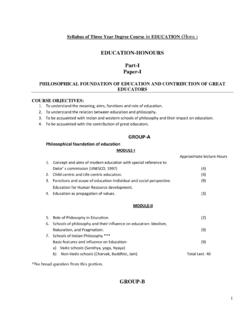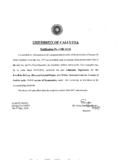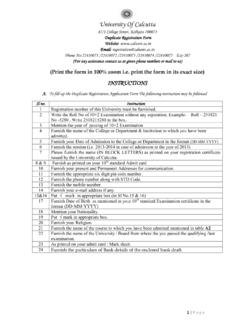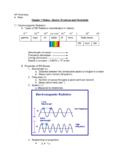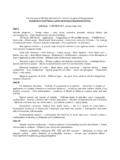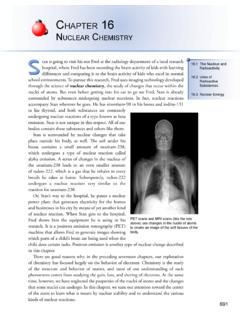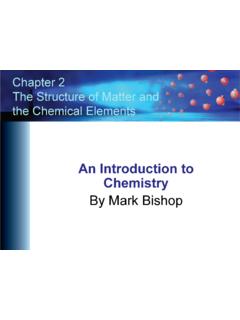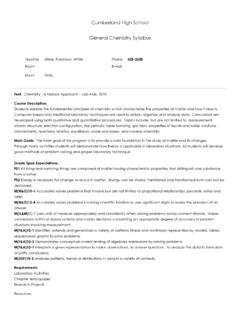Transcription of SYLLABI FOR THREE-YEAR B.Sc. HONOURS & GENERAL …
1 UNIVERSITY OF CALCUTTA. SYLLABI . FOR. THREE-YEAR HONOURS & GENERAL . COURSES OF STUDIES. chemistry 2010. 2010-2011. CONTENTS. Chem. Hons. Course: module names and distribution p2. Course contents Hons. Course: Year 1 p 3-7. Hons. Course: Year 2 p 8-11. Hons. Course: Year 3 p 12-19. Chem. Gen. Course: module names and distribution p 20. Course contents Gen. Course: Year 1 p 21-23. Gen. Course: Year 2 p 24-26. Gen. Course: Year 3 p 27-29. Appendices Appendix 1: Paper-wise distribution of modules (Hons. & GENERAL ) p 30. Appendix 2: Instructions about Theoretical Examinations p 31. Appendix 3: GENERAL instructions about Practical Examinations p 32. Appendix 4: Specific instructions about Practical Examinations p 33-36. Appendix 5: Recommended list of books p 37-38. 1. chemistry Hons: Syllabus Scheme in modular form Course names and distribution PART I (Year 1), total marks = 200 (Theory = 150, Practical = 50).
2 CHT 11a, 11b, each 25 marks, Theory CHT 12a, 12b, each 25 marks, Theory CHT 13a, 13b, each 25 marks, Theory CHP 14a+14b, 50 marks, Practical PART II (Year 2), total marks = 200 (Theory = 150, Practical = 50). CHT 21a, 21b, each 25 marks, Theory CHT 22a, 22b, each 25 marks, Theory CHT 23a, 23b, each 25 marks, Theory CHP 24a+24b, 50 marks, Practical PART III (Year 3), total marks = 400 (Theory = 250, Practical = 150). CHT 31a, 31b, 31c, 31d, each 25 marks, Theory CHT 32a, 32b, 32c, each 25 marks, Theory CHT 33a, 33b, 33c, each 25 marks, Theory CHP 34a, 34b, 25 and 50 marks, Practical CHP 35a, 35b, 25 and 50 marks, Practical ---------------------------------------- --------------------------------------- Abbreviations: CHP: Chem Hons Practical; CHT: Chem Hons Theory First digit refers to year, second to paper. ---------------------------------------- --------------------------------------- Each CHT Exam = 1 hr for 25 marks, 2 hr for 50 marks, etc.
3 Each CHP Exam = 2-3 hr for 25 marks, 4 hr for 50 marks on each day ---------------------------------------- --------------------------------------- Notes: 1. Each Theory module of 25 marks contains units I (marks = 15) and II (marks = 10). 2. Number of class hours = 25-35 for a 25-mark Theory module, 70-80 for a 25-mark Practical module. 2. chemistry Hons: Course Description Year 1. PART I. CHT 11a Unit-I. Radioactivity and atomic structure nuclear stability and nuclear binding energy. nuclear forces: meson exchange theory. nuclear models (elementary idea): Concept of nuclear quantum number, magic numbers. nuclear Reactions: Artificial radioactivity, transmutation of elements, fission, fusion and spallation. nuclear energy and power generation. Separation and uses of isotopes. Radio chemical methods: principles of determination of age of rocks and minerals, radio carbon dating, hazards of radiation and safety measures.
4 Bohr's theory to hydrogen-like atoms and ions; spectrum of hydrogen atom. Quantum numbers. Introduction to the concept of atomic orbitals; shapes, radial and angular probability diagrams of s, p and d orbitals (qualitative idea). Many electron atoms and ions: Pauli's exclusion principle, Hund's rule, exchange energy, Aufbau principle and its limitation. Electronic energy level diagram and electronic configurations of hydrogen-like and polyelectronic atoms and ions. Term symbols of atoms and ions for atomic numbers < 30. Unit-II. Chemical periodicity I. Periodic table, group trends and periodic trends in physical properties. Classification of elements on the basis of electronic configuration. Modern IUPAC. Periodic table. GENERAL characteristic of s, p, d and f block elements. Position of hydrogen and noble gases in the periodic table. Effective nuclear charges, screening effects, Slater's rules, atomic radii, ionic radii (Pauling's univalent), covalent radii.
5 Ionization potential, electron affinity and electronegativity (Pauling's, Mulliken's and Allred-Rochow's scales) and factors influencing these properties. Inert pair effect. Group trends and periodic trends in these properties in respect of s-, p- and d-block elements. CHT 11b Unit-I. Chemical Bonding and structure Ionic bonding: Size effects, radius ratio rules and their limitations. Packing of ions in crystals, lattice energy, Born-lande equation and its applications, Born-Haber cycle and its applications. Solvation energy, polarizing power and polarizability, ionic potential, Fazan's rules. Defects in solids (elemementary idea). Covalent bonding: Lewis structures, formal charge. Valence Bond Theory, directional character of covalent bonds, hybridizations, equivalent and non-equivalent hybrid orbitals, Bent's rule, VSEPR theory, shapes of molecules and ions containing lone pairs and bond pairs (examples from main groups chemistry ), Partial ionic Character of covalent bonds, bond moment, dipole moment and electronegativity differences.
6 Concept of resonance, resonance energy, resonance structures 3. Unit-II. Acid-Base reactions Acid-Base concept: Arrhenius concept, theory of solvent system (in H2O, NH3, SO2 and HF), Bronsted-Lowry's concept, relative strength of acids, Pauling rules. Amphoterism. Lux-Flood concept, Lewis concept. Superacids, HSAB principle. Acid- base equilibria in aqueous solution and pH. Acid-base neutralisation curves; indicator, choice of indicators. CHT 12a Unit I. Acyclic stereochemistry Representation of molecules in saw horse, Fischer, flying-wedge and Newman formulae and their inter translations, symmetry elements, molecular chirality. Configuration: stereogenic units i) stereocentres: systems involving 1, 2, 3. centres, stereogenicity, chirotopicity. pseudoasymmetric (D/L and R/S descriptor, threo/erythro and syn/anti nomenclatures (for aldols) ii) stereoaxis: chiral axis in allenes & biphenyls, R/S descriptor; cis/trans, syn/anti, E/Z descriptors (for C=C, C=N).
7 Optical activity of chiral compounds: specific rotation, optical purity (enantiomeric excess), racemic compounds, racemisation (through cationic and anionic and radical intermediates), resolution of acids, bases and alcohols via diastereomeric salt formation. Topicity of ligands and faces (elementary idea): Pro-R, Pro-S and Re /Si descriptors. Conformation: Conformational nomenclature, eclipsed, staggered, gauche and anti; dihedral angle, torsion angle, energy barrier of rotation, relative stability of conformers on the basis of steric effect, dipole-dipole interaction, H-bonding;. conformational analysis of ethane, propane, n-butane, haloethane, 1,2-haloethane, 1,2- glycol, 1,2-halohydrin; invertomerism of trialkylamines. Unit II. Bonding and physical properties Valence bond theory: concept of hybridisation, resonance (including hyperconjugation), orbital pictures of bonding (sp3, sp2, sp: C-C, C-N & C-O system).
8 Inductive effect, bond polarization and bond polarizability, steric effect, steric inhibition of resonance. MO theory: sketch and energy levels of MOs of i) acyclic p orbital system (C=C, conjugated diene and allyl systems) ii) cyclic p orbital system (neutral system: [4], [6]. annulenes; charged system: 3,4,5-ring system); Frost diagram, Huckel's rules for aromaticity & antiaromaticity; homoaromaticity. Physical properties: bond distance, bond angles, mp/bp & dipole moment in terms of structure and bonding (covalent & non covalent). Heat of hydrogenation and heat of combustion. CHT 12b Unit I. GENERAL treatment of reaction mechanism Mechanistic classification: ionic, radical and pericyclic; heterolytic bond cleavage and heterogenic bond formation, homolytic bond cleavage and homogenic bond formation; representation of mechanistic steps using arrow formalism.
9 Reactive intermediates: carbocations (cabenium and carbonium ions), carbanions, carbon radicals, carbenes structure using orbital picture, electrophilic/nucleophilic behaviour, stability, generation and fate (elementary idea). 4. Reaction thermodynamics: free energy and equilibrium, enthalpy and entropy factor, intermolecular & intramolecular reactions. Application of thermodynamic principles in tautomeric equilibria [keto-enol tautomerism, composition of the equilibrium in different systems (simple carbonyl, 1,3 and 1,2- dicarbonyl systems, phenols and related system), substituent and solvent effect]. Concept of acids and bases: effect of structure , substituent and solvent on acidity and basicity. Reaction kinetics: transition state theory, rate const and free energy of activation, free energy profiles for one step and two step reactions, catalyzed reactions, kinetic control and thermodynamic control of reactions, isotope effect , primary kinetic isotopic effect (kH/kD), principle of microscopic reversibility, Hammond postulate.
10 Unit II. Nucleophilic substitution reactions Sustitution at sp3 centre - Mechanism: SN1, SN2, SN2', SNi mechanisms, effect of solvent, substrate structure , leaving group, nucleophiles including ambident nucleophiles (cyanide & nitrite) substitution involving NGP; relative rate & stereochemical features [systems: alkyl halides, allyl halides, alcohols, ethers, epoxides]. Halogenation of alkanes and carbonyls. Substitution at sp2 carbon (carbonyl system) - Mechanism: BAC2, AAC2, AAC1, AAL1 (in connection to acid and ester). Systems: amides, anhydrides & acyl halides [formation and hydrolysis]. CHT 13a Unit I. Kinetic theory and the gaseous state Concept of pressure and temperature. Nature of distribution of velocities in one, two and three dimensions. Maxwell's distribution of speeds. Kinetic energy distribution in one, two and three dimensions, calculations of average, root mean square and most probable values in each case; calculation of number of molecules having energy , Principle of equipartition of energy and its application to calculate the classical limit of molar heat capacity of gases.


